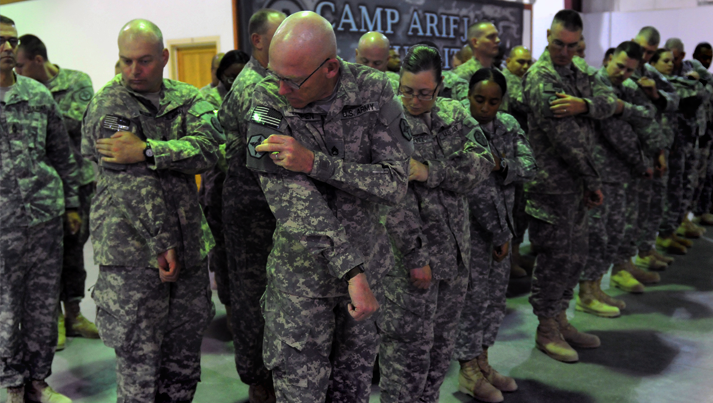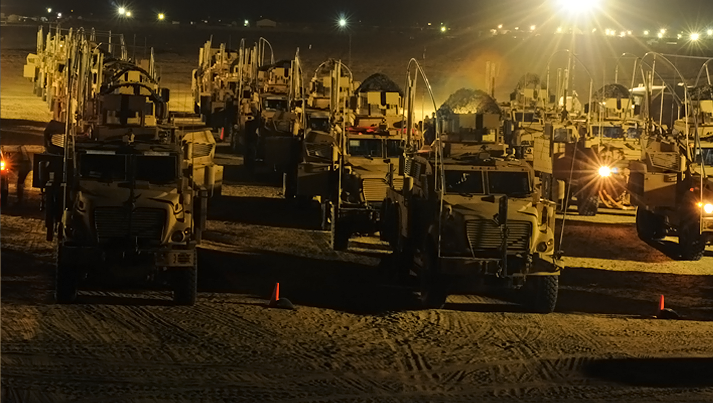364th ESC Manages Historic
Troop Withdrawal
The 364th Expeditionary Sustainment Command (ESC) recently wrapped up its mission at Camp Arifjan, Kuwait. The deployment began in September 2011 on very short notice to support the responsible drawdown of troops from Iraq. As the 364th ESC redeployed, its leaders and Soldiers knew that they were a key part of the Army’s sustainment mission during a critical moment of need.

Soldiers of the 364th Expeditionary Sustainment Command, USAR, from Marysville, Washington, receive their combat patches during a ceremony on 6 October 2011 at Camp Arifjan, Kuwait. The unit mobilized and deployed less than 5 months after its alert. (Photo by SGT Christopher A. Bigelow, 364th Expeditionary Sustainment Command)
The 364th ESC is a U.S. Army Reserve (USAR) unit that was activated in September 2009 at Fort Lawton, in Seattle, Washington, as part of the “Grow the Army” initiative. Stateside, the unit has mission command of more than 40 USAR units in 7 Western States, including 3 brigades: the 652d Regional Support Group (RSG), in Helena, Montana; the 654th RSG, in Tacoma, Washington; and the 96th Sustainment Brigade, in Salt Lake City, Utah.
The doctrinal mission of an ESC is to provide mission command for attached units in an area of operation as defined by a theater sustainment command (TSC). As a deployable command post for the TSC, the ESC provides operational reach and span of control. The ESC plans and executes sustainment, distribution, theater opening, and reception, staging, and onward movement for Army forces within the spectrum of conflict.
Under Army Force Generation (ARFORGEN) guidelines, USAR units undergo a 4-year process that involves the reset, train/ready, and availability for deployment phases. Based on the ARFORGEN cycle, the 364th ESC was not scheduled to mobilize or deploy until 2014. However, as U.S. forces prepared to withdraw from Iraq, it became apparent to Army planners that an ESC would be required to organize and direct convoy operations and to assist in moving thousands of personnel and millions of pounds of equipment.
The 364th, as the Army’s newest ESC, received the call while still in the train/ready phase of ARFORGEN. On 4 March 2011, the 364th ESC received alert and mobilization orders. The unit’s mobilization date was set for 28 July—less than 5 months from the time it was alerted.
The unit faced a number of challenges, not the least of which was finding Soldiers to fill its ranks. At the time of its alert, the 364th ESC was at approximately 45 percent of its authorized strength.

Convoys of civilian and military vehicles wait to be inspect-ed at Khabari Crossing, Kuwait, on 8 October 2011. Each vehicle coming from Iraq had to be inspected by Soldiers and customs before moving on to their destinations in Ku-wait. (Photo by SGT Christopher A. Bigelow, 364th Expedi-tionary Sustainment Command)
“The biggest challenge was in finding personnel [who] not only qualified for the duty position but also had recent or actual hands-on experience,” said Colonel John Sweeney, the 364th ESC G–1. The call went out across USAR for volunteers in an effort that filled out the 364th ESC’s roster.
“We [also] ensured personnel were scheduled for training at a military school or developed a local training program to enhance their qualifications,” said Colonel Sweeney. By the time the unit’s roster was filled, it included USAR Soldiers from 39 States, 2 countries, and 1 U.S. territory.
After undergoing pre- and post-mobilization training at Fort Hunter Liggett, California, and Fort Bliss, Texas, the 364th ESC arrived at Camp Arifjan on 16 September 2011. Now christened Task Force Rainier, the 364th ESC took charge of more than 4,000 servicemembers in the Middle East.
Once the 364th ESC was on ground in Kuwait, it received its mission from the 1st Theater Sustainment Command to help organize and direct the responsible drawdown of forces from Iraq. The 364th ESC was then 279 Soldiers strong, and those assigned just prior to the deployment were finding their way in the organization.
The support operations section was at the heart of the 364th ESC’s drawdown operations. Shortly after the unit arrived in Kuwait, a team was organized and dispatched to Camp Virginia, a sprawling base northwest of Kuwait City. The team, led by Colonel Fred Maiocco, the 364th ESC’s support operations officer, was responsible for managing and directing the hundreds of convoys bringing Soldiers and equipment out of Iraq.

Soldiers from the 82d Airborne Division have their identifi-cation cards scanned at Camp Virginia, Kuwait, on 16 No-vember 2011, to start the redeployment process. (Photo by SGT Christopher A. Bigelow, 364th Expeditionary Sustain-ment Command)
The 364th ESC, as the lead proponent of Camp Virginia’s redistribution property assistance team, had to stage and manage thousands people, vehicles, and pieces of equipment. According to Colonel Maiocco, the most difficult part of the operation was synchronizing all of the logistics requirements to make the entire operation work effectively. When convoys arrived at Camp Virginia, after trips that were several days and hundreds of miles long, they were greeted by teams of Soldiers chosen to lead the convoy teams through a step-by-step process designed to account for equipment, vehicles, and personnel.
As the convoys lined up, Soldiers were briefed on what to expect as they prepared to enter an assembly line-like supply turn-in station designed to collect and account for items Soldiers would not need stateside.
Captain Alex Savoia, a support operations integration officer with the 364th ESC, gave most of the briefings to arriving convoy commanders. While the Soldiers who had just arrived from Iraq were taking well-deserved breaks from their time on the road, the convoy commanders gathered in a conference room to hear how the next few days would go.
“At the height of the operation, we were working 14 to 16 hours a day,” said Captain Savoia. “When convoys got to Camp Virginia, our staff would meet them and go through the steps necessary to make turn-in and redeployment as painless as possible.”
Captain Savoia said the convoys would work their way through the turn-in yards, where stations had been set up to collect each class of supply. Class VIII (medical materiel) came first. Soldiers and medics turned in gear and medications that were no longer needed. A section was even dedicated to controlled medications, such as painkillers, that could not be carried back to Soldiers’ home stations.

A convoy of mine-resistant, ambush-protected vehicles from the 82d Airborne Division arrives at Camp Virginia, Kuwait, on 16 November 2011. Over the next 3 to 4 days, equipment from the convoy was turned in, allowing Soldiers to start the trip home. (Photo by SGT Christopher A. Bigelow, 364th Expeditionary Sustainment Command)
Class V (ammunition) was another tightly-controlled turn-in point. Soldiers working at the turn-in points made sure that all ammunition, from 5.56–millimeter rifle rounds to high-explosive shells for the main guns of tanks, was collected.
The entire process was geared to take 3 to 4 days. During this time, the 364th ESC provided every aspect of life support, including open-bay tents and dining facilities that offered food around the clock.
At Camp Virginia’s theater gateway, a team of personnel specialists made sure out-processing from the combat zone went smoothly. First Lieutenant Jill O’Dell, a USAR Soldier with the 18th Human Resources Company and officer-in-charge of the theater gateway, said Soldiers of the personnel accountability team made sure redeploying Soldiers were fully prepared to head home.
In addition to personnel services, the property accountability team ensured Soldiers were able to relax after coming out of Iraq by providing snacks, games, and other comfort items. These items helped Soldiers’ time at the theater gateway to pass quickly and smoothly. At the height of the drawdown, between 300 and 500 Soldiers were leaving Kuwait daily; nearly all passed through the theater gateway.
In mid-October 2011, President Barack Obama issued his directive to ensure that all U.S. combat forces were out of Iraq by year’s end. This posed significant logistics challenges for the 364th ESC because about 45,000 troops and many tons of equipment were still in the country.
Throughout the latter part of the year, logisticians at Camps Arifjan and Virginia worked 24 hours a day to meet the President’s directive. As operations peaked in November, additional personnel were shuttled back and forth between Camp Virginia, Camp Buehring, and Khabari Crossing (the main border outpost between Kuwait and Iraq—the point at which convoys came under direction of the 364th ESC movement control units).
Convoys had to clear customs at Khabari Crossing before heading to Camp Virginia or Camp Buehring. Soldiers, Department of Defense contractors, and third-country nationals all had a role in the drawdown; the movement control teams made it run smoothly.
On 18 December 2011, the last convoy from Iraq reached Khabari Crossing. Hundreds of Soldiers were gathered, and international media representatives were on hand to record the event. After more than 8 years, the war in Iraq was coming to a close, and the Soldiers of the 364th ESC were there to witness it.
“The most satisfying part of the operation was seeing the last vehicle out of Iraq arrive at Camp Virginia and seeing Soldiers smile about a job well done,” said Colonel Maiocco.
Once tallied, the final amounts that the 364th ESC had moved were staggering: more than 68,000 personnel moved, with 96,869 bags; more than 10,000 containers; and more than 9,100 trucks were used to make the move.
“This was the largest logistical operation since the Red Ball Express of World War II,” said Brigadier General Jonathan G. Ives, who was the commander of Task Force Rainier during its mission in Kuwait.



